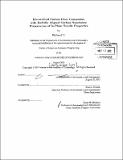| dc.contributor.advisor | Brian L. Wardle. | en_US |
| dc.contributor.author | Li, Richard, Ph. D. Massachusetts Institute of Technology | en_US |
| dc.contributor.other | Massachusetts Institute of Technology. Department of Aeronautics and Astronautics. | en_US |
| dc.date.accessioned | 2014-03-19T15:46:38Z | |
| dc.date.available | 2014-03-19T15:46:38Z | |
| dc.date.copyright | 2013 | en_US |
| dc.date.issued | 2013 | en_US |
| dc.identifier.uri | http://hdl.handle.net/1721.1/85806 | |
| dc.description | Thesis: S.M., Massachusetts Institute of Technology, Department of Aeronautics and Astronautics, 2013. | en_US |
| dc.description | Cataloged from PDF version of thesis. | en_US |
| dc.description | Includes bibliographical references (pages 89-94). | en_US |
| dc.description.abstract | Hierarchical carbon-nanotube (CNT)-based composites have significant potential to expand the performance and functionality of aerospace composite structures. Notably, circumferentially aligned CNT arrays have previously been grown on woven alumina filaments to form a "fuzzy fiber" reinforced plastic (FFRP) architecture with demonstrated improvements in inter- and intra-ply mechanical properties as well as multifunctional enhancement via tailorable electrical and thermal conductivities. However, thus far, the development of fuzzy carbon fiber reinforced plastics (fuzzy CFRP) with all-around enhanced mechanical properties has been elusive. In particular, prior work attaining growth of CNTs on carbon fibers (CF) have resulted in drastic reductions in fiber tensile strength (e.g., 55% loss), thereby compromising in-plane tensile properties of the resultant fuzzy CFRP. In this thesis, a novel method for high-yield growth of carbon nanotubes on carbon fiber is refined and implemented in the fabrication of unidirectional fuzzy CFRP plies with preserved tensile properties: Non-covalent functionalization of the CF surface coupled with a low temperature thermal chemical vapor deposition process enable high density catalyst adhesion and CNT growth below critical temperatures that would result in fiber strength loss. Successful scale-up to unidirectional fuzzy CFRP specimens with high (67%) and low (32%) CF volume fractions is presented. Testing results indicate that longitudinal elastic properties are retained for all fuzzy CFRP samples consistent with micromechanical analyses. Unexpectedly, the high fiber volume fraction fuzzy CFRP specimens show a 12% decrease in mean tensile strength that was hypothesized to be due to fiber damage introduced through transverse compression during processing of the fuzzy carbon fiber tows. As such, lower fiber volume fraction fuzzy CFRP specimens were subsequently tested and observed to retain strength. These advances pave the way for scale-up to fuzzy CFRP laminates with integrated multifunctionality and improved interlaminar performance without compromising in-plane mechanical properties critical to aerospace-grade composite materials. | en_US |
| dc.description.statementofresponsibility | by Richard Li. | en_US |
| dc.format.extent | 94 pages | en_US |
| dc.language.iso | eng | en_US |
| dc.publisher | Massachusetts Institute of Technology | en_US |
| dc.rights | M.I.T. theses are protected by copyright. They may be viewed from this source for any purpose, but reproduction or distribution in any format is prohibited without written permission. See provided URL for inquiries about permission. | en_US |
| dc.rights.uri | http://dspace.mit.edu/handle/1721.1/7582 | en_US |
| dc.subject | Aeronautics and Astronautics. | en_US |
| dc.title | Hierarchical carbon fiber composites with radially aligned carbon nanotubes : preservation of in-plane tensile properties | en_US |
| dc.type | Thesis | en_US |
| dc.description.degree | S.M. | en_US |
| dc.contributor.department | Massachusetts Institute of Technology. Department of Aeronautics and Astronautics | |
| dc.identifier.oclc | 872114398 | en_US |
